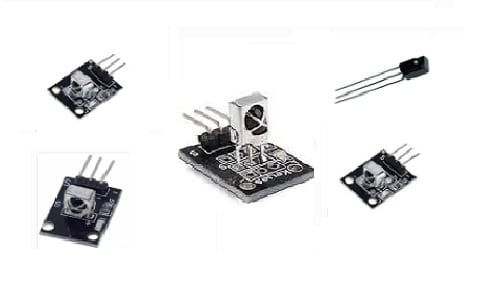Monolithic three-terminal linear voltage regulators appeared nearly two decades ago, which are simple to use & not expensive. So these regulators quickly eclipsed discrete and previous monolithic building blocks to dominate the market. LT1070 IC is a high power switching regulator manufactured previously by Linear Technology but acquired by Analog Devices Inc. While designing any circuit with this IC, some important things need to be considered like layout, power supply decoupling, … [Read more...]
LM2596 IC : PinOut, Features, Specifications, Circuit, Working, Datasheet & Its Applications
A step-down (buck converter) is a DC-to-DC converter that reduces voltage when current is increased from its input supply to its load. These converters provide much better power efficiency than linear regulators. Its efficiency is frequently over 90%, which makes it very useful for different tasks like changing the main supply voltage of a computer. So, step-down converters normally have a minimum of two semiconductors like a transistor and a diode, while current buck converters often change the … [Read more...]
Top Certification Courses for ECE Students to Boost Government Job Prospects
Electronics and Communication Engineering (ECE) is a diverse and high-potential branch of engineering. However, the competition for government jobs is intense. While core knowledge and strong fundamentals are essential, adding industry-relevant certifications can significantly enhance your chances of landing government job opportunities, especially in research, PSUs (Public Sector Undertakings, the defense, and the telecommunication sectors. In this article, we explore the top certification … [Read more...]
LM723 IC : PinOut, Features, Specifications, Circuit, Working, Datasheet & Its Applications
An adjustable voltage regulator is a type of voltage regulator IC whose regulated o/p voltage can be changed over a range. So there are two variations of the same like positive adjustable voltage regulator & negative adjustable regulator. The positive adjustable voltage regulator example is LM317. Similarly, the negative adjustable voltage regulator example is LM337, the complement of LM317 IC. An adjustable voltage regulator IC generates a DC output voltage. It can be changed to any other … [Read more...]
KY-027 Module : PinOut, Features, Specifications, Interfacing & It Applications
The magic light cup module is generally credited to Keyes Electronics which is a specialized company in Arduino-compatible modules. So this module is invented normally to make a visual effect wherever light emerges to transfer flawlessly between two modules when tilted. It imitates the act of pouring fluid from one cup to another cup, providing a visually appealing & interactive element mainly for electronics projects. This module is used in interactive displays or toys because of its … [Read more...]
Top 5 IR Receiver Modules Compared : KY-022 vs TSOP382 vs HX1838
In today’s world of remote-controlled systems, IR (Infrared) receiver modules play a vital role in enabling wireless communication between electronic devices. Whether you are building a home automation system, a DIY electronics project, or an industrial sensor network, IR receiver modules help decode signals from standard remote controls. This article compares five of the most popular IR receiver modules: KY-022, TSOP382, HX1838, VS1838B, and TL1838, focusing on their features, specifications, w … [Read more...]
KY-022 Module : PinOut, Features, Specifications, Interfacing, Working & Its Applications
An IR receiver module or IR receiver is an electronic component that detects & decodes emitted IR signals from a remote control. This module enables a device to receive remote commands by converting the IR light into a digital signal that the device can process. These modules receive IR radiation at a specific frequency and convert it into a data stream, allowing any processing unit to understand the information. Manufacturers widely use this module in various consumer electronics to enable … [Read more...]
LM7815 IC : PinOut, Features, Specifications, Circuit, Working, Equivalents, Datasheet & Its Applications
The fixed output voltage regulator is an integrated circuit from the LM78xx series. This series mainly includes LM7805, LM7812, LM7824, LM7809, etc. So these regulators are frequently used in electronic circuits to provide a stable output voltage for different input voltages. The term 78 in this series of regulators signifies a positive voltage regulator whereas the remaining number indicates the output voltage provided by the IC. But these ICs suffer from huge heat loss, thus a Heat sink is … [Read more...]
DIY Solar USB Phone Charger : Step-by-Step Guide
In a world increasingly reliant on sustainable energy, creating your own DIY solar-powered USB charger is not only a great eco-friendly project but also an excellent way to understand basic electronics. Whether you're an engineering student, hobbyist, or eco-conscious traveler, this project is simple, affordable, and doesn’t require advanced skills. This article provides brief information on a DIY solar USB phone charger step-by-step procedure. What is a Solar USB Phone Charger? A Solar USB C … [Read more...]
DIY USB Fan Powered by a Temperature Sensor
This article explains how to design a DIY USB fan that is powered by a temperature sensor. Additionally, it provides instructions on how to use a temperature sensor (LM35 or DHT11) to trigger a fan, how to power the project via USB, how to build a control circuit using a transistor, and how to test, calibrate, and upgrade the system. DIY USB Fan Powered by a Temperature Sensor The required components to make this DIY USB fan powered by a temperature sensor include the following. … [Read more...]
- 1
- 2
- 3
- …
- 66
- Next Page »









